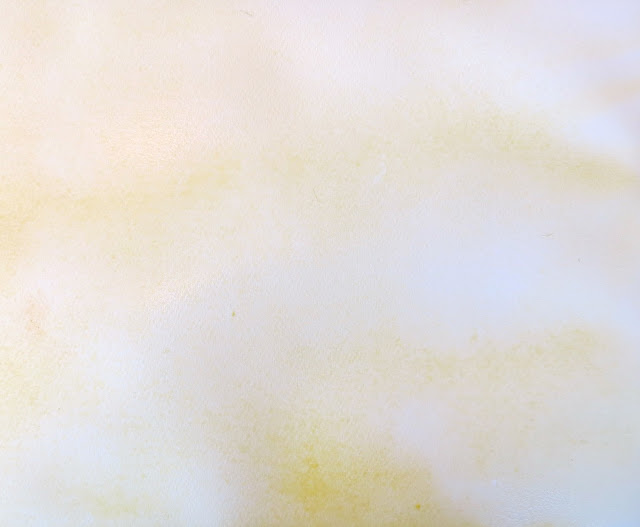For this fun negative painting project, you can look at a multi-petaled flower, if you like (mums, dahlias, zinnias, daisies) -- just to get the shape of the individual petals. But then, put away any references, so you don't get too hung up on making your drawing/painting look exactly like any particular flower.
To begin this painting, wet your paper, and then paint the entire area with a very light wash. I started with Quinacridone Gold. Make sure it is very pale for this first wash . . .
After your paper is completely dry, draw a tiny circle, a little off center. Now, draw an odd number of petals, radiating out from the little circle . . .
Using the same color you used for your underpainting, in this case, Quinacridone Gold, mix up a big batch of it. You will be painting wet-on-dry, so you'll need plenty of paint/water to cover all the negative space . . . (this should be just a little less pale than the first wash). If it's not pale enough, add more water.
To paint your wash over the negative space, use two brushes. Start with a small round brush, so you can easily paint around the petal shapes . . .
Once you have successfully painted around the petals, switch to a larger brush . . .
Keep painting this wash, until you've covered all the negative space . . .
After the paper is totally dry, draw some more petals -- varying the shapes somewhat, as well as the spaces between the petals . . .
Using this same wash, with additional water and more Gold pigment added, paint the negative space -- wet on dry. Don't paint any of the petals that you've drawn. And, remember to use your small brush to paint around the petals, and to switch to your bigger brush to paint the rest of the negative space.
After this dries, draw more petals, remembering to vary the shape and the length of each petal, as well as the spaces between the petals. Let some petals touch, to form interesting little negative shapes . . .
Then, paint the negative space again. This time, add a little Quinacridone Burnt Orange, or Burnt Sienna, to your Gold Wash. No need to go too dark, too fast. And, don't forget to paint those little negative shapes . . .
When that wash is dry, draw more petals . . .
Paint the negative space, wet on dry, with a wash that is mostly Quinacridone Burnt Orange, or Burnt Sienna, now . . .
Once again, let that layer dry completely, and then draw some more petals . . .
And for this layer, use a wash of just Quinacridone Burnt Orange, or Burnt Sienna . . .
Draw some more petals, taking some of them off the edge of the paper. To your Burnt Sienna mixture, add some Quinacridone Magenta, and paint the negative shapes . . .
Add more petals, and another layer of Quin Burnt Orange/ Quin Magenta mixture to the negative space
You can keep adding more petals and more layers of washes, as long as you want -- until you run out of paper . . .
Try this same negative painting approach, using blues or roses, and differently-shaped petals. You could also draw the petals gradually bigger and wider for each layer.


















I’m not sure of the purpose or intention of this exercise. It is just to practice painting in the negative space? If so, why so many negative space practice projects?
ReplyDelete